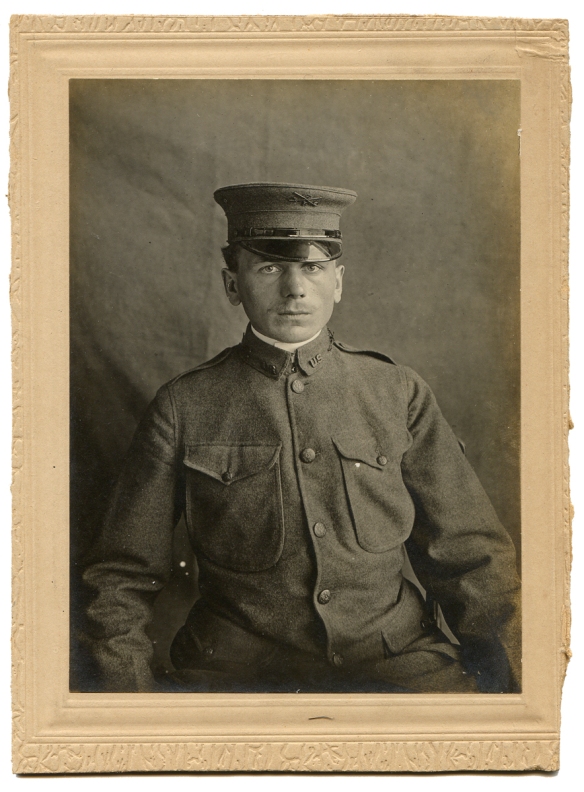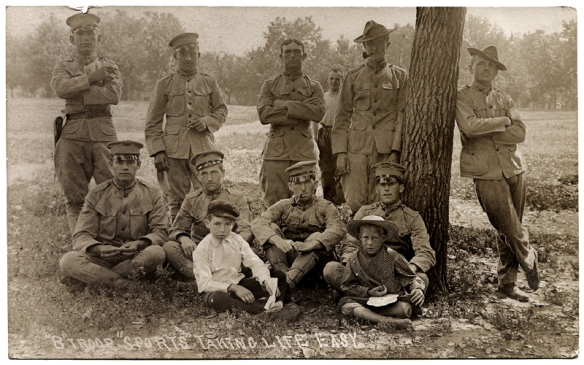Serving His Adopted Homeland
This photographic study of a member of “B” Troop, 7th United States Cavalry would have remained unidentified had it not been for the lucky inclusion of this soldier’s calling card with the lot when purchased.
 Above: Private Emil Paul Vieweg of the 7th U.S. Cavalry poses in his M1911 winter service tunic ans M1905 service cap at Fort Riley, Kansas c. 1908. Mounted Photograph (trimmed) 6 3/4 Inches by 4 7/8 Inches (17.5 cm x 12.5 cm), Unknown Photographer
Above: Private Emil Paul Vieweg of the 7th U.S. Cavalry poses in his M1911 winter service tunic ans M1905 service cap at Fort Riley, Kansas c. 1908. Mounted Photograph (trimmed) 6 3/4 Inches by 4 7/8 Inches (17.5 cm x 12.5 cm), Unknown Photographer
Fort Riley, Kansas, United States. Source: Collection of Edward T. Garcia/soldiersofthequeen.com
Born at Greiz in eastern Thuringia, Germany, on September 16, 1885, Emil Paul Vieweg arrived in the United States in 1906 and like so many other recent immigrants enlisted in the army soon thereafter on 14 December 1907. Attached as a private to “B” Troop of the famed 7th U.S. Cavalry, Vieweg served out his term of enlistment at Fort Riley, Kansas. He took his discharge on 13 December 1910. At that time his character was listed as “Excellent”. By 1910 he had already declared his intent to become a U.S. citizen and by 1920 his application had been granted.

Above: Private Emil Vieweg’s calling card used while he was a member of “B” Troop, 7th Regiment, United States Cavalry. His photographic portrait is attached to the card in the manner and size of a postage stamp. The photograph is exactly the same image seen in the
larger photo shown above. The card and larger portrait were in all likelihood produced as a package. Such packages were probably offered at a discount and sold in various combinations to the soldiers stationed at Fort Riley. 2 Inches by 3 1/2 Inches
(5.2 cm x 9.1 cm) c. 1908. Source: Collection of Edward T. Garcia/soldiersofthequeen.com
Army life must have agreed with him but perhaps having grown tired of the rather flat and boring landscape of Kansas, Vieweg re-enlisted as a private on 23 May 1911 at Fort Wadsworth, New York this time with 53 Company, United States Coast Artillery Corps. If Vieweg had intended to make a career in the army it was a short-lived hope since he was admitted to Walter Reed Army Hospital for an unknown reason on 11 November 1912. He returned to duty at Fort Wadsworth, New York on 23 December 1912 after more than a year in the hospital. Vieweg was discharged for disability on 16 May 1913. At this time his character was stated as being “good”. He applied for an army disability pension on 5 June 1918. Interestingly this application did not prevent his registering for the draft on 12 September 1918. I have found no evidence of Vieweg serving another hitch during World War One.
According to the above-mentioned draft registration, Vieweg was married with his wife’s name being Theresa. He was employed as a timekeeper with the J. L. Sommers Manufacturing Company, a firm that produced “wire novelties”. The couple made their home in Newark, New Jersey. The couple was still residing in Newark in 1930 during which time Vieweg was now employed as a department store manager.

Above: A Real Photo Postcard titled “B Troop Sports Taking Life Easy”. The photograph was taken somewhere in the vicinity of Fort Riley, Kansas c 1908 shows nine members of B Troop, 7th United States Cavalry as well as three young men who may have been the sons of some of these soldiers. Private Emil Vieweg stands at far right leaning against the tree. Source: Collection of Edward T. Garcia/soldiersofthequeen.com
In the 1930 United States Census, all adult males had their status as veterans listed. Even though Vieweg clearly served in the U.S. Army he was listed as a non-veteran. I have seen several other similar cases and apparently the enumerators for the 1930 census only listed those former soldiers who had served in a war as veterans. For those men who the “veteran” box was marked “yes” it was always followed by a notation of “WW” for World War One, “SP” for the Spanish-American War and in a few cases by this late date “CW” for Civil War. It should also be noted that there was no veteran credit given to those soldiers who had taken part in the many Indian Wars – at least I have never seen one listed as such.
Vieweg and his wife who was 17 years his senior seem to have remained childless. By 1940 he was widowed and living at he Soldier’s Home Hospital in Washington DC. He passed away on 4 December 1947 and was buried at the Soldier’s Home National Cemetery, Washington DC.
